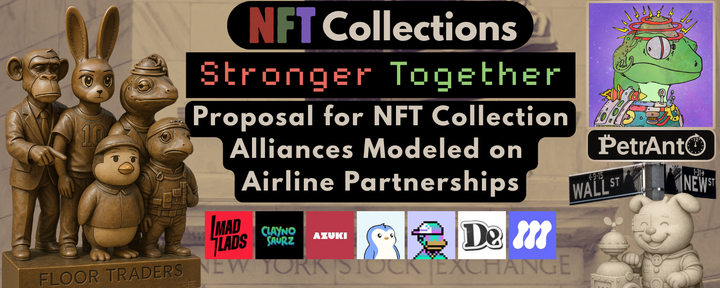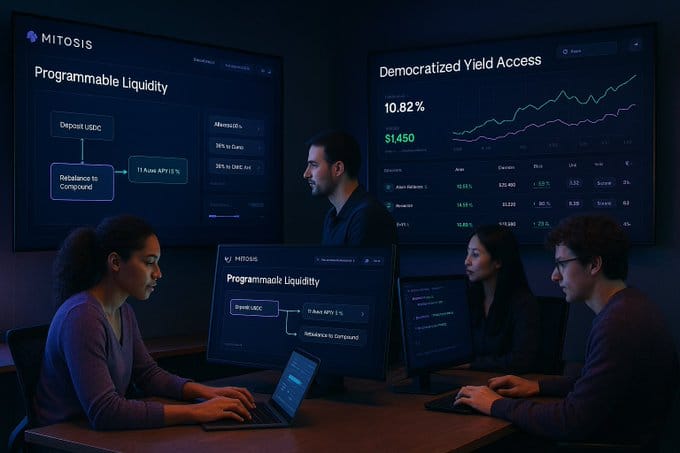Why Cross-Chain Gaming will be Defi's Next Growth Engine (and how Mitosis Prepares)

Introduction: The Convergence of Gaming and DeFi
The decentralized finance (DeFi) ecosystem has undergone explosive growth, with innovations like automated market makers (AMMs), yield farming, and liquid staking reshaping how users interact with financial protocols. However, the next major catalyst for DeFi’s expansion may come from an unexpected sector: cross-chain gaming.
Web3 gaming is rapidly evolving beyond simple play-to-earn models, with studios now focusing on true digital ownership, asset interoperability, and sustainable in-game economies. Yet, a critical challenge remains—fragmented liquidity across blockchain networks.
This is where Mitosis, a programmable liquidity network, comes into play. By enabling cross-chain asset interoperability, yield optimization, and tokenized liquidity, Mitosis is uniquely positioned to bridge DeFi and gaming, unlocking new economic opportunities for players, developers, and liquidity providers.
In this article, we explore:
- Why cross-chain gaming is the next frontier for DeFi adoption.
- How Mitosis’s architecture solves key liquidity challenges in gaming.
- Real-world use cases for Web3 game studios integrating Mitosis.
- The future of gaming as a liquidity engine for DeFi.
1. The Rise of Cross-Chain Gaming: Why It Matters for DeFi
The Problem: Siloed Assets and Fragmented Liquidity
Most Web3 games today operate on a single blockchain, locking players’ assets (NFTs, tokens, in-game currencies) within that ecosystem. This creates several inefficiencies:
- Limited Utility: A sword earned in an Ethereum-based game cannot be used in an Avalanche-based game.
- High Bridging Costs: Manually transferring assets between chains is expensive and slow.
- Inefficient Capital Use: Idle in-game assets cannot be leveraged for DeFi yield opportunities.
The Solution: Cross-Chain Interoperability
Cross-chain gaming allows:
✅ Seamless asset portability (e.g., using the same character skin across multiple games).
✅ Dynamic pricing via multi-chain liquidity pools.
✅ Integration with DeFi for staking, lending, and yield generation.
Why DeFi Needs Gaming Liquidity
Gaming generates massive, engaged user bases—imagine millions of players interacting with DeFi through in-game assets. This could:
- Boost TVL (Total Value Locked) as players deposit assets into liquidity pools.
- Increase transaction volumes as gamers trade, lend, and stake assets.
- Drive innovation in tokenized asset markets (e.g., NFT-collateralized loans).
2. How Mitosis Enables Cross-Chain Gaming Economies
Mitosis’s programmable liquidity infrastructure is tailor-made for gaming’s needs. Here’s how:
A. Tokenized Liquidity for In-Game Assets (miAssets & maAssets)
Mitosis converts illiquid LP positions into tradable tokens (miAssets for Ecosystem-Owned Liquidity, maAssets for curated campaigns). For gaming, this means:
- Game studios can tokenize in-game currencies (e.g., "Gold Coins" as maAssets) and let players earn yield on them.
- Players can trade LP positions (e.g., stake in-game tokens in a liquidity pool and receive a tradable miAsset).
B. Cross-Chain Asset Bridging (Mitosis Vaults)
- Vanilla Assets (1:1 representations of deposited assets) allow games to support multi-chain currencies.
- Example: A player deposits ETH into an Ethereum-based game vault and receives Vanilla ETH on Mitosis Chain, which can then be used in an Avalanche-based game.
C. Liquidity Campaigns for Game Economies (Matrix Framework)
Game studios can use Mitosis’s Matrix Framework to:
- Offer yield incentives for players who lock assets (e.g., "Stake our in-game token for 3 months and earn 15% APY").
- Bootstrap liquidity for new games by attracting DeFi participants.
D. Governance-Driven Liquidity (EOL Framework)
- Game DAOs can collectively manage liquidity pools via miAsset governance.
- Example: A gaming guild votes on how to allocate pooled assets across different yield strategies.
3. Real-World Use Cases: How Game Studios Can Leverage Mitosis
Use Case 1: Cross-Chain NFT Marketplaces
- Problem: NFTs from one game are useless in another.
- Mitosis Solution:
- Mint wrapped NFTs as maAssets (e.g., "wSword" usable across chains).
- Allow players to stake NFTs in liquidity pools and earn yield.
Use Case 2: Yield-Generating In-Game Currencies
- Problem: In-game tokens sit idle in wallets.
- Mitosis Solution:
- Convert game tokens into miAssets and integrate with DeFi lending markets.
- Players earn interest simply by holding in-game money.
Use Case 3: Guild Treasuries with DeFi Integration
- Problem: Gaming guilds struggle to manage pooled assets efficiently.
- Mitosis Solution:
- Use EOL governance to let guild members vote on yield strategies.
- Allocate funds across chains for optimal returns.
4. The Future: Gaming as DeFi’s Liquidity Growth Engine
A. Mass Adoption Through Gamification
- DeFi is complex—but gaming makes it intuitive.
- Example: A player "farms yield" by completing in-game quests, not by navigating a DEX.
B. Sustainable In-Game Economies
- Mitosis enables auto-rebalancing liquidity pools, reducing inflation risks in play-to-earn models. One of the biggest challenges in blockchain gaming—especially in play-to-earn (P2E) models—is the unsustainable emission of tokens. Many early GameFi projects suffered from runaway inflation, where rewards were too generous, and demand couldn’t keep up. This led to massive sell pressure, token crashes, and ultimately, the collapse of many game economies. Mitosis addresses this head-on by introducing programmable, cross-chain liquidity infrastructure that allows game developers to build more balanced, self-adjusting economies.
C. Institutional-Grade Liquidity for Indie Studios
- Small studios can tap into Mitosis’s aggregated liquidity instead of relying on volatile token launches. In traditional and blockchain gaming alike, independent studios often face a major hurdle: bootstrapping liquidity. Most rely on token launches or NFT pre-sales to raise capital and fund development. But these strategies are:
- 🎢 Highly volatile
Mitosis changes the game by providing institutional-grade liquidity infrastructure, accessible even to small or mid-tier game studios.
💧 Aggregated Cross-Chain Liquidity Pools
At the heart of Mitosis is its unified liquidity layer, where assets and yield strategies are abstracted across chains. Indie studios can plug into this system to:
- Access deep, on-demand liquidity
- Avoid the overhead of creating isolated liquidity pools
- Tap into a multi-chain network of yield-hungry capital
Instead of launching a high-risk token or begging whales for support, studios can simply integrate with Mitosis and access ready-to-use liquidity across ecosystems.
🔐 Institutional-Grade = Programmable + Secure + Predictable
Mitosis provides primitives that meet the needs of institutional players—predictability, composability, and security. Indie developers benefit from this too:
- ✅ Stablecoin-backed liquidity pools
- ⚖️ Auto-balancing incentives that adapt to in-game activity
- 🔄 Rehypothecation-enabled mechanisms, allowing liquidity to be reused across protocols without fragmentation
This means developers focus on the game, while Mitosis handles the financial plumbing.
🛠️ Tools for Builders
Mitosis isn’t just a liquidity layer—it's a developer-friendly ecosystem, offering:
- SDKs and APIs to integrate liquidity features into in-game economies
- Yield tokenization and staking templates for reward mechanics
- Plug-and-play DeFi integrations, reducing dev overhead and time-to-market
Indie studios get enterprise-grade infrastructure, without needing a DeFi team or massive treasury.
🎮 TL;DR
Mitosis empowers indie game studios to build sustainable, scalable economies without the need for risky token launches.
By tapping into aggregated, cross-chain, institutional-grade liquidity, they get:
- Access to capital
- DeFi composability
- Financial stability from day one
- 🧑⚖️ Regulatory gray areas
- ⌛ Often unsustainable long-term
Conclusion: The Play-to-Liquidity Revolution
Cross-chain gaming is set to become DeFi’s next growth engine, and Mitosis provides the critical infrastructure to make it happen. By enabling:
- True asset interoperability
- Seamless cross-chain liquidity
- Yield-generating in-game economies
Mitosis ensures that Web3 gaming evolves beyond speculation into a sustainable, liquidity-rich ecosystem.
The future of gaming isn’t just play-to-earn—it’s play-to-liquidity. And Mitosis is building the rails to make it happen.
Final Thoughts:
- For Players: Earn yield on assets you already own.
- For Studios: Build deeper economies with cross-chain liquidity.
- For DeFi: Tap into gaming’s massive user base for the next wave of adoption.
Would you like additional details on specific game integrations or technical deep dives into Mitosis’s smart contract architecture?



Comments ()